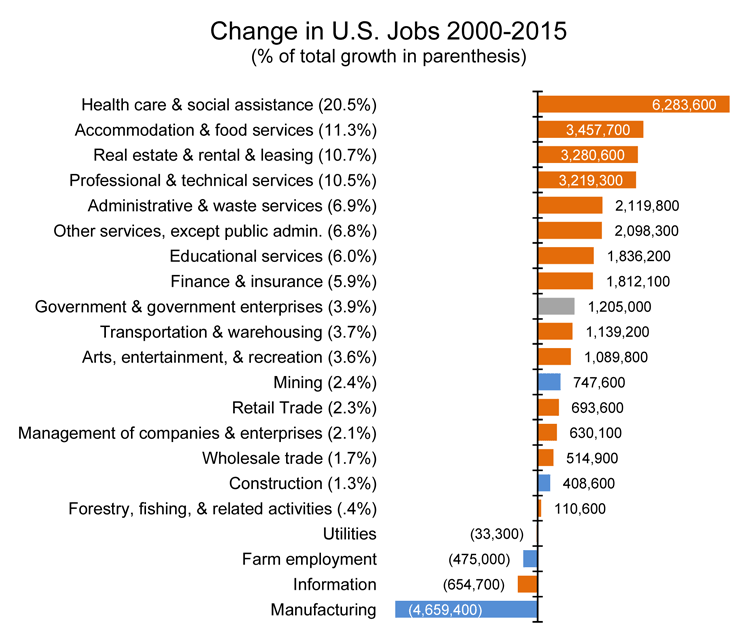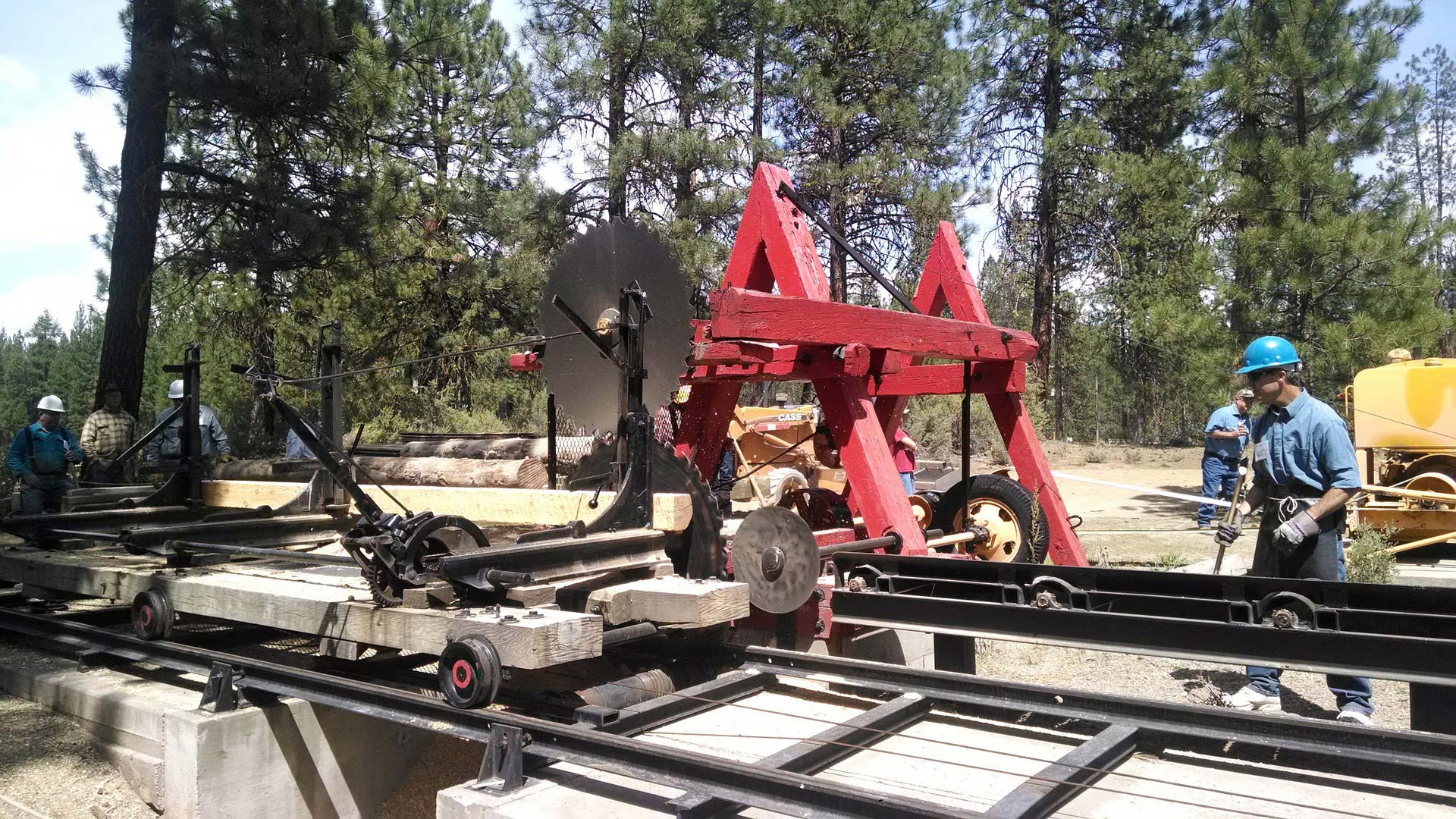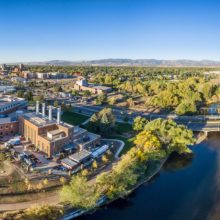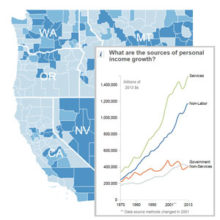- Manufacturing’s contribution to Gross Domestic Product continues to rise and has never been higher. Yet manufacturing has been shedding jobs for decades, largely due to automation.
- This paper reviews national trends in manufacturing and draws insights for the West.
- We conclude that manufacturing jobs are declining in the rural West, yet there are surprising examples of manufacturing thriving in rural communities that have found ways to capitalize on unique advantages.
Much has been written lately about the decline of manufacturing in the United States economy and the loss of high-wage factory jobs that were available to people without advanced education.1 This paper reviews recent trends in manufacturing and what they mean for the people and communities of the American West2 with insights for rural areas in particular.3
Manufacturing employment in the U.S. has declined steadily for the last 40 years from almost 21 million workers in 1980 to 19 million in 2000. More recently, the count has been hovering around 13 million workers. Of the almost two million manufacturing jobs lost during the Great Recession (2007 to 2009), fewer than half have been restored.4
At the same time that manufacturing has been shedding jobs, this sector’s contribution to Gross Domestic Product—the measure of the sector’s total value of production—has never been higher. In real terms, manufacturing’s contribution to GDP grew from $1.66 trillion in 1980 to $2.14 trillion in 2000 and $2.17 trillion in 2015.5
Manufacturing therefore continues to be a significant and growing contributor to the U.S. economy, but it is doing so with fewer and fewer people. Compared to 1980, there are eight million fewer manufacturing workers today while manufacturing’s contribution to GDP rose by more than $509 billion.
As the interactive above shows, the disconnect between GDP growth and job loss is not typical of other industries in which the value of production and jobs rise and fall together.
In the West, in 2015, the 11 continental western states contained 19 percent of U.S. manufacturing jobs. This region also has seen trends that mirror those on a national scale such as increased productivity and employment declines. Also, the rural West contains only six percent of the West’s manufacturing jobs, yet there are surprising examples of manufacturing thriving in some rural communities.
Where Did the Manufacturing Jobs Go?
Industrialized countries worldwide are seeing a decline in factory jobs. In Germany, manufacturing employment dropped from 35.8 percent of all jobs in 1970 to 18.5 percent in 2009 (latest data). During the same period, manufacturing employment in France dropped from 24.3 percent to less than 12 percent; and in the United Kingdom the drop was from almost 30 percent to less than 10 percent.6
Conventional wisdom holds that U.S. manufacturing jobs have been lost to outsourcing to countries with cheaper labor, such as China. That is only part of the story. The loss of manufacturing jobs in the U.S. started decades ago, well before the rise of China as a manufacturing center. Only about a quarter of the decline in manufacturing jobs from 1990 to 2007 can be attributed to imports from China.7,8
Much of the explanation for the decline of manufacturing jobs is due to automation—an accelerating global phenomenon. According to one study, 88 percent of the loss of manufacturing jobs in the U.S. from 2000 to 2010 can be explained by increases in productivity due to advances in labor-saving technology.9
Even China will see a decline of manufacturing workers due to automation. According to a recent article in MIT Technology Review, “…countless manufacturers in China are planning to transform their production processes using robotics and automation at an unprecedented scale. In some ways, they don’t really have a choice. Human labor in China is no longer as cheap as it once was….” Yet, as in the U.S. and elsewhere, China has no clear answer about what to do with displaced factory workers: “The transition from human to robot workers may upend Chinese society. Some displaced factory workers could find employment in the service sector, but not all of the 100 million now employed in factories will find such jobs a good match.”10
The automation of manufacturing processes will likely continue to accelerate and affect American workers. According to MIT Technology Review, one measure for comparison is the number of robots per 10,000 workers. In South Korea, where the industry is highly automated and where manufacturing’s share of employment has dropped from 28 percent of employment in 1991 to 17 percent today,11 there are 478 robots per 10,000 workers. In Japan, the figure is 315 robots per 10,000 workers, and in Germany, 292. In the U.S., there are currently only 164 robots per 10,000 workers—illustrating the potential for increased automation.12
In 2013 researchers at University of Oxford published a now famous paper predicting the number of U.S. jobs that could be automated. They analyzed all jobs, categorized them by occupation, and estimated the probability that the occupation would be lost to automation, a computer, or robot. The authors estimated that 47 percent of the jobs in the U.S. have a high probability of being lost to automation.13 A 2015 study by McKinsey Consulting focused on activities that could be automated rather than on occupations, and found that 45 percent of activities could be automated with current technologies and that these activities are spread across all occupations to some degree.14
A key insight from the Oxford paper is that occupations with a low probability of automation require strong interpersonal skills with work that requires complex perception and improvisation. Jobs likely to be automated are those in which the work is routine, repetitive, and predictable.
Further automation of manufacturing is likely—it will raise GDP—but there is no guarantee that jobs will follow.
Manufacturing Vs. Other Sectors
Although manufacturing jobs have declined in the U.S., other employment sectors have increased significantly. In 1980 manufacturing jobs represented 22 percent of the workforce, dropping to 15 percent in 2000 and further down to around seven percent by the mid-2000s. From 2000-2015, manufacturing lost more than 4.6 million workers even though the U.S. economy overall created almost 31 million new jobs during that time. During the same period of time, service-related industries (in orange in figure below)—led largely by the health care industry—created 28 million new jobs, more than making up for the loss in manufacturing.15

Some fast-growing service-related industries pay higher wages than manufacturing, but require advanced education. In 2016 the national average hourly wage for manufacturing was $26.37 compared to $37.29 per hour in professional, scientific, and technical services, $26.30 per hour in health and social assistance, and $45.43 per hour for medical and health services specifically.16
While manufacturing employment is predicted to decline three percent from 2014 to 2024, other occupations are growing. For example, health care jobs are expected to grow by 19 percent, and jobs such as environmental engineers and technical writers are expected to grow by more than 10 percent. A key difference is that while the typical manufacturing job in assembly and fabrication requires a high school diploma, the relatively higher-wage components of the service sector most often require a university degree.17
What This Means for the Rural West
As noted earlier, in 2015, the 11 continental western states contained 19 percent of U.S. manufacturing jobs with increased output but with fewer workers. And while the manufacturing sector lost jobs, other sectors grew. During the first half of the 2000s, the 11 western states created almost 7.7 million new jobs, 93 percent of them in service-related occupations, while the manufacturing sector lost more than 591,000 jobs.18
In the West, more than 2.5 million people work in manufacturing, but 94 percent are in metropolitan areas.19 The remaining six percent of the West’s share of manufacturing jobs equated to a little more than 155,000 jobs spread throughout the West’s non-metro counties in 2015. In a typical rural western county, only 4.5 percent of jobs are in manufacturing.
The interactive below shows the distribution of rural western manufacturing jobs.
Wood products manufacturing offers an example of how automation and increased efficiencies have impacted the rural West. Historically the wood products industry has been one of the most visible forms of western manufacturing. It has supported higher wage jobs, often in remote communities dependent on timber from national forests and other public lands.
Oregon is one of the most timber-dependent states in the country. The figure at left shows how Oregon’s wood products manufacturing sector employment has declined while output per worker has increased – an indication of the efficiencies gained from automation.
The same pattern emerges in the figure at left that looks at west-wide trends over a 40-year period and shows an overall steady decline in the number of lumber mills even as average production increases.20
Automation is not the only culprit affecting wood products. The global financial crisis and massive decline in the U.S. housing market decreased the demand for wood products and further contributed to a loss of sawmills, resulting in the closure of 30 large mills in the West between 2009 and 2010 and a loss of 71,000 jobs from 2005 to 2009.21
Those mills that survived the recession emerged much more efficient. In Oregon, for example, timber harvests increased by 50 percent between 2009 and 2013, while timber employment increased by only one percent.22
Despite automation, manufacturing has not disappeared entirely from the rural West. More than 600 timber mills still serve timber operations in western states23 and enterprising entrepreneurs have built unique manufacturing operations in western rural communities that take advantage of regional strengths.
For example, high-end cosmetics are hand-crafted in a USDA-approved organic lab and shipped from Vapour’s manufacturing facility in Taos, New Mexico. In Cody, Wyoming, Y-Tex is a 40-year-old local business that employs approximately 100 workers who manufacture livestock identification ear tags and ship them to customers worldwide. Rural Kanab, Utah, is home to the manufacturing plant of Stampin’ Up!, a 23-year-old, multi-million-dollar company that creates decorative rubber stamps for home decor and craft projects. Chinook Medical Gear assembles custom products for field emergency medical situations at its green-powered facility in Durango, Colorado. And the town of Sandpoint (population 7,412) in the rural panhandle of Idaho has become a manufacturing hub with aerospace businesses among others, despite being distant from major population centers and more than an hour’s drive from Spokane.24
Manufacturing thrives in parts of the rural West for different reasons. In some communities, rural labor costs may be cheap enough to overcome disadvantages like increased shipping expenses, resulting in a comparative advantage over higher-cost locations. In other rural communities, the advantage may be competitive. For example, the outdoor lifestyle and friendly, small-town atmosphere in Sandpoint, Idaho, attract and keep talent. Other communities capitalize on proximity to resources: Simms Fishing Products in Four Corners, Montana, the only fishing wader manufacturer in the country, is located close to several premiere fishing rivers, while family-owned Vaagen Brothers Lumber in Colville, Washington, has worked with regional forest resources for more than 50 years.
Rural economic development has to be about diversity and resilience. Manufacturing will continue to play a role, but the vast majority of rural jobs will reflect the shift we have seen in the rest of the country where almost all new jobs have been created in the service sectors. Enrico Moretti, in his book The New Geography of Jobs, illustrates this stark reality by pointing out that over the past 50 years, the U.S. has shifted “from an economy centered on producing physical goods to one centered on innovation and knowledge,” where the important elements to success are creativity and ingenuity, not just access to raw materials.25 This shift hits at the core of much of America’s anxiety about who has the advantage in today’s economy and will continue to be reflected in elections and economic policies in the future.
Endnotes
- 1. According to the Bureau of Labor Statistics, manufacturing includes “plants, factories, or mills and characteristically use power-driven machines and materials-handling equipment. However, establishments that transform materials or substances into new products by hand or in the worker’s home and those engaged in selling to the general public products made on the same premises from which they are sold, such as bakeries, candy stores, and custom tailors, may also be included in this sector.” ↑
- 2. The West is defined here as the 11 western contiguous states: Arizona, California, Colorado, Idaho, Montana, Nevada, New Mexico, Oregon, Utah, Washington, and Wyoming. ↑
- 3. In this post we define rural as non-metro. Metro counties contain a core population of 50,000 or more people or are “outlying” counties and tied economically to the core areas by labor force commuting↑
- 4. U.S. Department of Commerce. 2016. Bureau of Economic Analysis, Regional Economic Accounts, Washington, D.C. Table CA25N. ↑
- 5. U.S. Department of Commerce. 2016. Bureau of Economic Analysis, Regional Economic Accounts, Washington, D.C. Regional Economic Accounts.↑
- 6. Organisation for Economic Co-operation and Development. OECD. Stat.↑
- 7. Author DH, Dorn D, and Hans GH. 2013. The China Syndrome: Local Labor Market Effects of Import Competition in the United States. American Economic Review 103(6): 2121–2168. A recent example illustrates how the factors that make one country relatively cost-competitive are not entirely due to wages. It is $4,300 cheaper to manufacture a car in Mexico than in the U.S., but only $600 of the savings is due to cheaper labor rates. The rest is due to saving on parts and tariffs with countries where the U.S. has no free trade agreements. See Welch D and Merrill D. 2017. Why Trump Tariffs on Mexican Cars Probably Won’t Stop Job Flight. January 4, 2017. Bloomberg. ↑
- 8. Another partial explanation for the loss of manufacturing jobs may be attributed to how industries are counted in official statistics. Some functions, such as accounting and marketing, are outsourced and therefore now counted as part of services rather than manufacturing. In other words, the U.S. still makes things, but engineering, finance, and marketing are no longer taking place in the factory and therefore these jobs are no longer counted as “manufacturing.” According to one estimate, about a quarter of the decline in manufacturing in the last 60 years may be attributable to a shift in how industries are measured. See Berlingieri G. 2014. Outsourcing and the shift from manufacturing to services. VOX. Washington, DC: Center for Economic and Policy Research. ↑
- 9. Hicks MJ and Devaraj S. 2015. The Myth and the Reality of Manufacturing in America. Muncie, IN: Center of Business and Economic Research, Ball State University. ↑
- 10. Knight W. 2016. China Is Building a Robot Army of Model Workers. April 26, 2016. MIT Technology Review. ↑
- 11. Kenny C. 2014. Why Factory Jobs are Shrinking Everywhere. April 28, 2014. Bloomberg. ↑
- 12. Knight W. 2016. China Is Building a Robot Army of Model Workers. April 26, 2016. MIT Technology Review. ↑
- 13. Frey CB and Osborne MA. 2013. The Future of Employment: How Susceptible Are Jobs to Computerisation? Oxford, UK: Oxford Martin School, University of Oxford.↑
- 14. Chui M, Manyika J, and Miremadi M. 2015. Four Fundamentals of Workplace Automation. November 2015. McKinsey Quarterly. ↑
- 15. U.S. Department of Commerce. 2016. Bureau of Economic Analysis, Regional Economic Accounts, Washington, D.C. Table CA25N.↑
- 16. Two examples illustrate how the loss of manufacturing has been more than replaced by some service industries at either equal or higher wages. While in 2016 manufacturing represented 12.2 million jobs nationwide (average $26.37/hour), 19.3 million people were employed in professional, scientific and technical services ($37.29/hour), and another 8.5 million in health and social assistance ($26.30/hour and $45.43/hour for medical and health services specifically). Bureau of Labor Statistics – Industries at a Glance.↑
- 17. U.S. Department of Labor, Bureau of Labor Statistics. 2015. Occupational Outlook Handbook. ↑
- 18. U.S. Department of Commerce. 2016. Bureau of Economic Analysis, Regional Economic Information System, Washington, D.C. Table SA25N.↑
- 19. In 2015, there were 2,564,523 manufacturing jobs in the 11 western states with 155,580 in non-metropolitan counties, representing 6 percent of total. U.S. Department of Commerce. 2016. Bureau of Economic Analysis, Regional Economic Accounts, Washington, D.C. Table CA25N.↑
- 20. Oregon Office of Economic Analysis. Wood Products Productivity, an Update. Analysis of Oregon’s wood products industry also showed that while wages in wood products industry used to be 30 percent higher than state average, today they pay the state average. .↑
- 21. Keegan CE, Sorenson CB, Morgan TA, Hayes SW, and Daniels JM. 2011. Impact of the Great Recession and Housing Collapse on the Forest Products Industry in the Western United States. Forest Products Journal 61(8): 625-634. ↑
- 22. Oregon timber harvest data were obtained from: Bureau of Business and Economic Research, University of Montana. Lumber and wood products manufacturing employment figures were obtained from: U.S. Department of Commerce. 2016. Bureau of Economic Analysis, Regional Economic Accounts, Washington, D.C. Table SA25N. Figures showing the relationship between sawmill productivity and harvests can be found at: Oregon Office of Economic Analysis. Wood Products Productivity, an Update. Analysis of Oregon’s wood products industry also showed that while wages in wood products industry used to be 30 percent higher than state average, today they pay the state average.↑
- 23. Personal communication with Chelsea McIver, Bureau of Business and Economic Research, University of Montana, with data derived from state reports.↑
- 24. Lawson M. 2015. Bonner County, Idaho’s Resilient Economy. Bozeman, MT: Headwaters Economics. ↑
- 25. Moretti E. 2012. The New Geography of Jobs. Boston, MA: Houghton Mifflin Harcourt.↑





